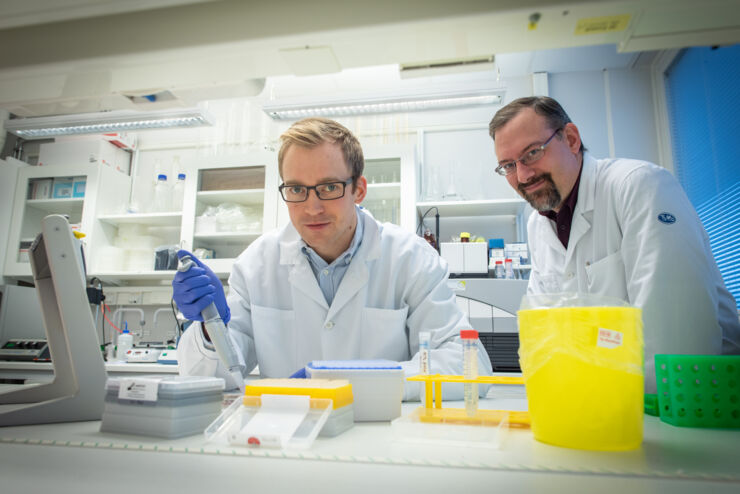
Henrik Gréen and Niclas Björn at Linköping university study the role of genetic factors in the response of an individual to cancer treatments. Image Credit: Magnus Johansson/Linköping University
The risk of serious effects on blood status and bone marrow during chemotherapy could be predicted with a prediction model, developed by LiU researchers. In the long run, it may be possible with genetic analysis to find patients who are at high risk for side effects.
Cancer treatment is often a challenging balancing act between getting rid of as many tumor cells as possible, and not at the same time causing too severe side effects.
One of the characteristics of tumor cells is that they usually multiply rapidly and uncontrolled. Drugs used to treat cancer – chemotherapy or chemotherapy as it is also called – are therefore developed to specifically kill fast-growing cells. But the treatment also kills normal cells that divide quickly.
One of the more sensitive tissues is the bone marrow, where different types of blood cells are formed at a rapid rate.
Around one in four lung cancer patients who receive combination therapy with the chemotherapy types gemcitabine and carboplatin have such a large effect on the bone marrow that the side effects in these cases are life-threatening. In many cases, treatment must be stopped.
It is known that genetic factors play a role in the individual’s sensitivity to these treatments. Probably a factor as to why they’re doing so poorly.
The researchers behind the current study are therefore working to investigate whether there are genetic signatures that can be used to predict which patients are at high risk of having severe side effects from the treatment.
This is to be able to better adapt the treatment to the individual from the beginning – those with a low risk of side effects may receive higher doses that have a greater effect on the cancer cells, and those with the highest risk may receive another treatment.
Bioinformatics meets pharmacogenetics
The study, published in the journal npj Systems Biology and Applications , is a collaboration between researchers in pharmacogenetics and bioinformatics.
They used whole genome sequencing of DNA from 96 patients with non-small cell lung cancer treated with gemcitabine / carboplatin. Sequencing of the entire genome provides information on millions of genetic variants that could potentially be interesting.
The researchers wanted to see if in this large amount of data they could find functional groups of genes that were associated with the degree of toxicity that the treatment had on the bone marrow for different patients.
In a first step, the researchers identified a network of genes that were closely linked to each other, a total of 215 genes ( see illustration below ).
The network is enriched for genes that in previous studies have been associated with these drugs. In the next step, the researchers were able to reduce the number of genetic variants belonging to the gene network down to the 62 genetic variants included in the final prediction model.
In the study, the researchers show that the model can be used to group patients into two groups with a high or low probability of having severe side effects.
We think it is very interesting that these are genes that have to do with cell proliferation, especially in bone marrow cells. We not only succeed in predicting the side effects for the patients, but the prediction model also seems to be biologically relevant, says Henrik Gréen, professor at the Department of Biomedical and Clinical Sciences, BKV.
The prediction model needs to be evaluated in more studies before it can be used in healthcare. More and more advanced genetic analysis methods are gradually being introduced in Swedish healthcare, something that makes it possible in the long run to introduce this type of method, which is based on analysis of many genes at the same time.
We want to work for a standard in translational bioinformatics and show that the same type of methodology can be applied to several different medical issues.
Although the patient material is small, we can show that this approach can be used to predict the degree of side effects for patients, says Mika Gustafsson, senior lecturer at the Department of Physics, Chemistry and Biology (IFM), who led the study together with Henrik Gréen.
The study has been funded with support from, among others, the Cancer Foundation, the Swedish Research Council, Linköping University, Region Östergötland.
Source: Linköping University
Sign up for the QuackTrack.org newsletter below!













